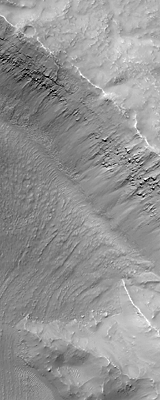MGS MOC Returns to Service Following Solar Conjunction Hiatus
 PIA01043 |  PIA01044 |
Many aspects of our studies of Mars from Earth are dictated by the different rates at which the two planets orbit the Sun. This difference allows Earth to pass Mars in its orbit, continue to lead Mars around the Sun, and then eventually overtake Mars again, every 26 months. This cycle governs opportunities to send rockets to Mars when the closest approaches between the two planets occur (opposition). The cycle also dictates when Mars will pass behind the Sun relative to Earth (conjunction). A Solar Conjunction period has just ended. During this time radio communications from the Mars Global Surveyor spacecraft, operating at Mars, were interrupted for a few weeks. Because it would not be able to send pictures back to Earth during this time, the Mars Global Surveyor (MGS) Mars Orbiter Camera (MOC) was turned off on June 21, 2000, and turned back on again July 13, 2000. The two pictures shown here are among the very first high resolution views of the martian surface that were received following the resumed operation of the MOC. Both pictures arrived on Earth via radio downlink on Saturday, July 15, 2000.
The first picture (above left) shows a ridged and cratered plain in southern Hesperia Planum around 32.8°S, 243.2°W. The second image (above right) shows the layered northeastern wall of a meteor impact crater in Noachis Terra at 32.9°S, 357.6°W. Both pictures cover an area 3 kilometers (1.9 miles) wide at a resolution of 6 meters per pixel. Both are illuminated by sunlight from the upper left.
